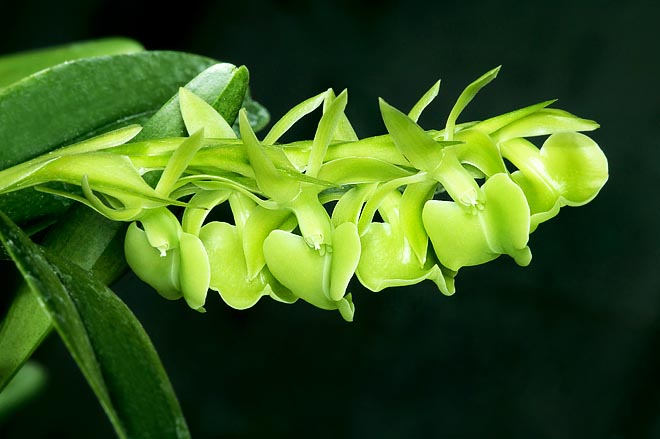Family : Orchidaceae

Text © Pietro Puccio

English translation by Mario Beltramini

The coriaceous and waxy odd green flowers of Epidendrum coriifolium form 10-25 cm racemes © Giuseppe Mazza
The name of the genus come from the combination of the Greek terms “epi” = over, and “déndron” = tree, with reference to the numerous species of the genus which live on the trees; the name of the species is the combination of the Latin terms “corium” = leather and “folium” = leaf, with obvious reference.
The Epidendrum coriifolium Lindl. (1851) is an epiphytic, lithophytic or terrestrial species with creeping rhizome from which do originate compressed stems, 12-25 cm long and 0,5-0,8 mm thick, covered at the base by imbricate bracts, with 2-8 distichous, coriaceous, rigid, concave and keeled leaves of green colour with purple shades at the base, 8-25 cm long and 1-3 cm broad.
The inflorescence is terminal, racemose, 10-25 cm long, with big hard, wrapping bracts, carrying 4-10 flowers opening in succession, coriaceous, waxy, of 3-5 cm of diameter, of pale green colour.
The sepals are elliptic with pointed apex, thick, 2 cm long and 1 cm broad, the petals have the same length, but are thinner, the labellum is ample, stretched, roundish, about 2 cm broad and 1,8 cm long, with, at the centre, a callus relief; the flowers smell at night, smell that many deem not really pleasant, and last about one month. The species characterizes also for an abundant exudation. It reproduces by seed, in vitro, and by division.
It is a species characteristic for the green flowers, of waxy consistency, and requires, during the vegetative period, in spring-summer, medium-high temperatures, partial shade, abundant and regular waterings and fertilizations and high atmospheric humidity, 60-80%.
During the resting time the waterings are to be reduced, leaving the compost to partially dry up, but without having the leaves to become wrinkled and the luminosity is to be increased, with night minimum temperatures not lower than the 15 °C.
Good air circulation is important during all seasons. For the waterings and the nebulisations is to be utilized rainwater, or water obtained from reverse osmosis or demineralised; the fertilizations, duly distributed and alternated, in way to avoid salts accumulations at the roots, are to be done preferably with hydro-soluble balanced products, with microelements, at ¼ of the dosage suggested on the package. It can be mounted on bark, raft of cork or of arborescent ferns roots or cultivated in pots or baskets with much draining and aerated compost, which can be formed by medium sliced bark fragments, sphagnum and charcoal. Repottings, transplants and divisions are to be done by the end of the flowering.
The species is inscribed into the appendix II of the CITES (species whose trade is internationally ruled).
Synonyms: Epidendrum fuscopurpureum Schltr. (1922); Epidendrum subviolascens Schltr. (1923).
→ For general notions about ORCHIDACEAE please click here.
